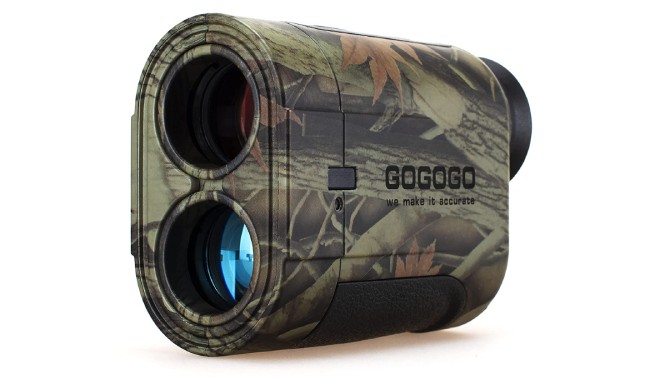If you’re a passionate archer, a vigilant hunter, a hard-working golfer, or even a friendly birdwatcher, You’ll certainly need a rangefinder. They resemble monoculars, but provide totally different outcomes.
In general, a rangefinder allows you to measure the distance between you and your target accurately without using any traditional measuring method. But how does a rangefinder work? What’s the secret?
Well, that’s what we’re discussing today. This guide will provide a simplified working principle to help you understand your rangefinder better.
We’ll talk about different kinds of rangefinders and how they estimate the distance accurately. I’ll also talk about some types and how they function differently to suit the purposes they are manufactured to serve.
Let’s get straight down to business!
What Is a Rangefinder
Rangefinders are devices that measure the distance between two points or objects. They use either laser beams or ultrasonic waves to determine and display the exact range in meters (m) or yards (yds).
Laser rangefinders are the most common type of rangefinders you can find today. They use specialized laser beams to measure the accurate distance up to a few kilometers.
What Does a Rangefinder Do?
Rangefinders are used in a variety of applications such as hunting, golfing, astronomy, forestry, and archery.
Hunters use rangefinders to measure the distance between them and their prey accurately. Archers and bowhunters can use it to ensure they hit their target from any distance.
Golfers use it to measure the distance to the flag from their position. And birdwatchers use rangefinders to identify distant birds and calculate their distance accurately.
How Does a Rangefinder Work: Understanding Rangefinders Technologies

Depending on the device, there are several different kinds of rangefinder technologies. Each type has its own advantages and disadvantages. Let’s figure out how do rangefinder works based on the different technology used.
1. Laser Rangefinders

Laser rangefinders have pretty simple workaround. It shoots laser beam (typically at a speed as high as that of light) from the emitter to initiate its function.
So how does laser rangefinder work? Here’s how:
When you press the trigger, a laser beam is sent out to your target. A computer chip which is already available inside your unit measures the time it took the laser to travel the distance and calculates the distance from there.
Then, you see the ranges on the display. Due to the speedy operation (like that of light), you don’t need to wait longer than a few seconds to get the reading which is oftentimes accurate and reliable enough.
Among the available technologies for hunting and birdwatching, this one stands at the top firmly with its accuracy and reliability.
Most units using this technology give accuracy of +/-1 yard, which should be enough for anyone undertaking a very detailed hunting adventure or a leisurely event (watching birds, animals, and wandering about the thick forests).
2. Optical Rangefinders

Optical rangefinders are the most economical type. They use a combination of optics, built-in scales, and camera lenses to measure the distance between two objects.
These devices work by sending out an invisible infrared light beam that reflects off the object and then comes back to the unit. The internal computer then uses the beam reflected to compose a digital image.
Once that is done, the computer calculates the distance between points by comparing two images – one taken from the object and one taken at a known reference point. There is a pre-loaded conversion chart inside the computer to provide the list or graph for distance reading.
Optical rangefinders are not as accurate as laser rangefinders, but they are still reliable enough to be used for hunting and other activities. They can measure distances up to a few hundred yards and are much more economical than laser rangefinders.
3. Ultrasonic Rangefinders
Ultrasonic rangefinders are the most advanced type of rangefinder. They use sound waves instead of light to measure the distance between two points. Laser and optical rangefinders work a bit better with reflective targets, but the ultrasonic ones work with any type of object.
These devices work by sending out a high-frequency sound wave that bounces off an object and then comes back to the unit where it is converted into a digital image by a computer.
The computer then calculates the distance between points using the time taken for the sound wave to travel from one point to another.
Unlike laser rangefinders, ultrasonic rangefinders don’t require a line of sight to measure distances. This makes them ideal for hunting and other activities in enclosed spaces or any other environment where it’s not possible to get a direct view of the target.
4. Radar Rangefinders
Radar rangefinders use radio waves to measure the distance. They work by sending out a radio wave that reflects off an object and then comes back to the unit where it a computer processes this data and provide accurate readings.
This type of rangefinder is highly accurate and can measure distances up to several kilometers with pinpoint accuracy.
Radar rangefinders are the most expensive type of rangefinder, but they are also the most reliable and accurate. They are ideal for military applications, long-range shooting/surveying, and many other activities where accuracy is of utmost importance.
5. Lidar Rangefinders
Lidar rangefinders are the latest technology in rangefinding. They use a combination of light, sensors, and computers to measure the distance between two points.
These rangefinders are not yet widely available, but they offer a level of accuracy that is hard to beat. They are expensive and require specialized training for operation, but their high accuracy makes them invaluable tools in many industries.
The working principle here is similar to the radar rangefinder, but it works on a much larger scale. Lidar rangefinders are even more accurate than radar rangefinders and are becoming increasingly popular in various fields such as automotive, surveying, and military applications.
How Do Rangefinders Work For Different Purposes
There are various purposes you can use the rangefinders for. You can use rangefinders when hunting or playing golf to improve the skill of getting the proper target.
Have you ever wondered about how your golf/hunting rangefinder works? Let’s explore different types of rangfinders based on their purposes to get a better idea.
1. Golf Rangefinder

Golf rangefinders are designed to help golfers measure the exact distance of their shots when playing a round of golf.
These devices come with different features, such as being able to calculate the slope and elevation of your shot, helping you to choose the right club for your target. They also have high accuracy and can be used over long distances.
So, how does a golf rangefinder work? Here’s how
A golf rangefinder uses laser technology to measure the distance between the golfer and the target (typically the flagstick).
The device emits a laser beam that bounces off the target and returns to the rangefinder, which then calculates the time it took for the beam to travel there and back to determine the distance.
The golfer views the distance through the rangefinder’s lens, which often also includes a magnification feature.
2. Hunting Rangefinder

Hunting consists of several different things to consider. There are different hunting tactics if you have rifle, bow hunting or shooting purposes.
Hunting rangefinders are designed to help hunters measure the exact distance between them and their target. But how does it do that? how does a hunting rangefinder work? Let’s find out.
These devices use lasers or ultrasonic waves to measure the distance accurately and quickly, allowing you to get a better shot without having to guess the distance. They are often used to help hunters track and aim at their targets.
They come with some additional features compared to the golf rangefinders. Some of the features include scan mode to identify moving target, multiple targeting mode, and angle compensation.
3. Telescope Rangefinder
Telescope rangefinders are mainly used by astronomers and stargazers to measure the distance between them and celestial bodies in the night sky.
These devices use laser technology or ultrasonic waves to accurately measure the distance between two points in the sky. They are often used to measure the size and distance of stars, planets, galaxies, and other celestial objects.
4. Forestry Rangefinder

These rangefinders mainly used in forestry or in the deep forest. They are designed to be accurate and rugged so they can withstand the elements.
These devices use lasers, ultrasonic waves, and other technologies to accurately measure the distance between two points on the ground or in the air. They are often used to measure the size and distance of trees, as well as the height and width of a forest.
These rangefinders also use the anti-leaf features which enable a user to reach their target with ease. Other features includes the capability to determine the height of the trees, the volume and getting the distance in between the device and target.
5. Ballistic Rangefinders

Ballistic rangefinders are designed specifically for military and law enforcement applications. They are used to measure the distance from a shooter to their target, which is especially important in combat situations.
These rangefinders use complex algorithms and mathematical formulas to calculate the exact trajectory of objects in flight. This allows for more accurate shots over long distances, even in difficult weather conditions.
This device has maximum ranges up to 1500 yards making itself ideal for military projectile release.
And there you have it. I’ve covered the basics without filling too much of the technicality into your head. However, I’ll be happy to inform you further upon any question or suggestions regarding rangefinder or other optics. Happy outing!
FAQs
Do Rangefinders Work At Night?
Yes, there are rangefinders that are specially designed for night use. These rangefinders usually employ infrared technology, which is not affected by darkness and can accurately measure distances even in complete darkness.
How Far Does A Rangefinder Work?
The range of a rangefinder varies depending on the type and model. Most golf rangefinders will work up to 400 yards, while hunting rangefinders can reach up to 1000 yards. Telescope rangefinders are designed for astronomical use, so they have much longer ranges than other types of rangefinders.
Do Rangefinders Automatically Turn Off?
Yes, most rangefinders will automatically turn off after a certain period to save battery life. The amount of time varies depending on the model, but most rangefinders will shut off after a couple minutes of inactivity.
What Kind Of Laser Do Rangefinders Use?
Most rangefinders use a type of laser called an Infrared or Class 1 laser. This type of laser is invisible to and safe for human eyes; but can be used to measure distances up to 1000 yards with extreme accuracy.
Do Rangefinders Factor Wind?
No, most rangefinders do not factor in wind speed when calculating distance. If you are looking for a device that can take into account environmental factors such as wind, look for one that has an advanced ballistic computer built in to it.









Leave a Comment